

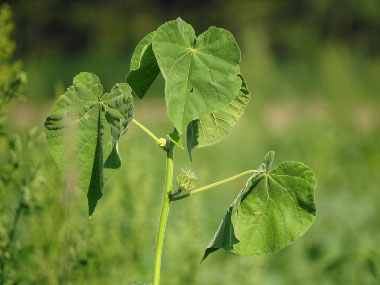
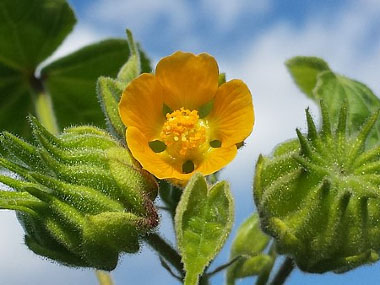
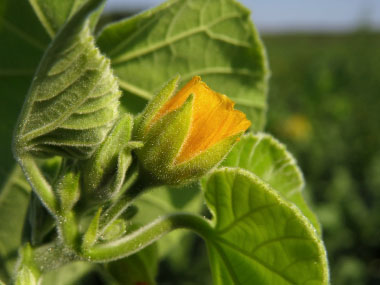
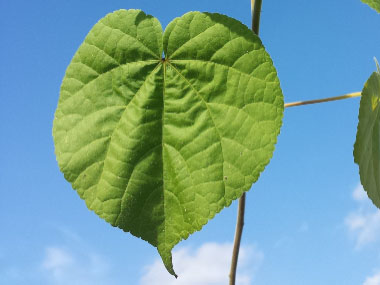
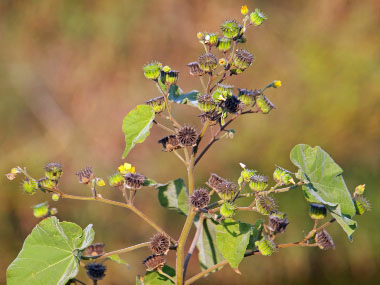

To support our efforts please browse our store (books with health benefits, etc.).
Velvetleaf originated in either China or India. This plant has a long history of use, dating back to 2,000 BC as a fiber crop in China. It is still grown there for fiber which is used to make nets, paper, ropes, and more. Velvetleaf was first seen in North America just before 1700, and was widespread on the East Coast by the early 1700s. This plant was cultivated in the U.S. as a fiber crop until the mid 1800's. Velvetleaf's common name comes from the soft leaves which are covered in short hairs, creating a velvety feel. It is in the mallow family (Malvaceae). The name Abutilon is from an Arabic name and was created around 900 B.C., by Avicenna (Ibn-Sina) for plants resembling a mallow or mulberry. Velvetleaf is self-fertilizing and can produce up to 17,000 seeds per plant; seeds are viable in the soil up to 50 years. If you are in the woods, the soft leaves can be used as a substitute for toilet paper.
Distinguishing Features
Velvetleaf is a tall and lanky plant with large, heart-shaped leaves that are rather easy to identify in the field.
Flowers
Yellow flowers grow on individual stems from the leaf axils. Each flower has 5 petals and 5 green sepals, which are covered with fine, soft hairs. The flower blooms anywhere from June to August depending on location and can bloom into early autumn, yet they are short lived. Flowers become round, green, seed pods with a ring of prickles at the top. Pods are divided into 10 to 15 sections. Each section contains many heart-shaped seeds. From the upper leaf axils, sometimes develops a single flower about 2cm (3/4") across.
 Fields
of Nutrition has medicinal benefits and vitamin/mineral content of Velvetleaf.
Fields
of Nutrition has medicinal benefits and vitamin/mineral content of Velvetleaf.
Leaves
Heart-shaped leaves are large (about 20cm, or 8" long) and covered on both sides with tiny hairs that make the leaf feel remarkably soft. The tip of the leaf is pointed. They grow alternate and have long petioles (10cm, or 4") attached to the central stem. The leaf margin is slightly dentate. Leaves are mostly light green, although the upper surfaces of the leaves tend to be dull green.
Height
Under optimum conditions, this plant can reach to over 2 metres (6') Stems are round and covered with fine hairs.
Habitat
Velvetleaf grows in cropland, especially corn fields, and it can be found along roadsides and in gardens. This plant prefers rich and cultivated soils, such as those used in agriculture yet can thrive in waste areas and in fields.
Edible Parts
According to PFAF, seeds, raw or cooked are edible. The ripe seed is dried and ground into a powder then used in soups, bread, etc. The seed contains about 17.4% protein, 16% fat, and 33.8% carbohydrate.
Other Name
Indian Velvet Leaf.
Winter Survival Food Handbook

PDF Plant Magazines
Types of Wild Food
Geographic Zones Seasons
Disclaimer
EdibleWildFood.com is informational in nature. While we strive to be 100% accurate, it is solely up to the reader to ensure proper plant identification. Some wild plants are poisonous or can have serious adverse health effects.
We are not health professionals, medical doctors, nor are we nutritionists. It is up to the reader to verify nutritional information and health benefits with qualified professionals for all edible plants listed in this web site. Please click here for more information.
Why Edible Wild Food?
- Food costs are rising
- Free, wild food is readily abundant
- Wild food adds nutrition to your diet
- Wild food can help treat various medical conditions





